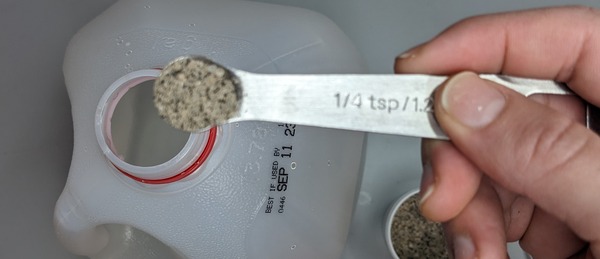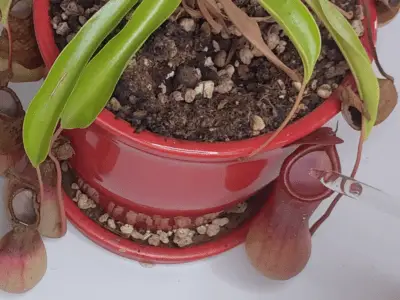Pitcher plants come in all shapes and sizes and they are very easy to feed.
Pitcher plants do not need to eat insects to survive. They extract additional nutrients from insects that help stimulate growth, but that are not required for survival. Pitcher plant owners can let their plant capture insects, feed them or skip the feeding without any harm.
However, as a Pitcher plant owner I do recommend feeding your nepenthes or Sarracenia as it helps promote growth (larger and brighter pitchers and leaves), and encourages propagation. Your plant will likely divide a lot more and generate baby pitchers
How to Feed Pitcher Plants
Feeding a pitcher plant is very easy, just follow these instructions. First, what should you feed pitcher plants?
Feed pitcher plants by dropping a live or dead insect into a pitcher, you can also employ dehydrated bugs, diluted Maxsea fertilizer, or fish food. Feed several or all pitchers and repeat the process every two to four weeks.
Use insects that fit within the pitcher of your plant and preferably select some small enough so they can be completely submerged in the pitcher’s liquid. I made a complete list of pitcher plant food in this article and listed some examples of some common insects you can use:
- Flies
- Cricket
- Mealworms
- Caterpillars
- Ants
- Bloodworms
Never feed human food such as raw meat, chicken, candy, and fruit to your pitcher plant. Such food will rot, stink, and attract pests.
You can also use dehydrated freeze dried insects.
Use freeze-dried insects to feed your pitcher plant by first soaking them in distilled water for 5 minutes, padding them dry, and dropping them inside a pitcher.
This links will take you to Amazon.com to view the availability of these products. Both options are extremely nutritious and very affordable (less than $10 with enough food to feed a pitcher plant for years.)
You can feed healthy pitcher or half dried pitchers as long as they have digestive fluid inside the pitcher, they will be able to consume insects. If they do not have any liquid, consider adding a few drops of distilled water and assessing their growing conditions.
Healthy Pitcher plants will produce their own liquid (this guide will help you resolve this issue). Dry pitchers are usually a sign of improper watering and lack of lighting.
How to Fertilize Pitcher Plants
Fertilize your pitcher plant by following this easy instructions:
First, never fertilize the soil of your plant. Pitcher plants are very sensitive to nutrients in the soil. Fertilizer in the soil will kill them. You can try fertilizing the leaves, but that is not the optimal strategy.
Instead, drop fertilizer inside the pitchers.

Use 1/4 of a teaspoon of Maxsea fertilizer diluted in a gallon of distilled water. Mix well and drop 2-3 drops of the solution inside each pitcher. Repeat once a month for best results.
You can choose to feed or fertilize your pitcher plant. However, none are a requirement to keep them alive. So… do not get stressed if you are not able to do it 🙂
The recommendation is to decide between feeding insects or fertilizing one at a time. Adding too much inside the pitcher at a single time can burn the pitcher and kill it.
Pitcher Plant Care Information
Read this pitcher plant care guide for a complete overview and the summary below for a consolidated checklist:
| Care Consideration | Recommendation |
|---|---|
| Lighting | This consideration is one of the most critical ones. Expose your plant to more than 10 hours of natural or artificial light. LED or fluorescent lights are suitable for indoor locations, 6500K is a suitable light temperature. |
| Watering | Only employ pure water sources such as distilled water, rainwater, or reverse osmosis water. Water consistently and keep the soil humid at all times. Avoid the tray method for Nepenthes. Since watering your plant correctly is critical, this guide explains the process in great detail. |
| Soil | Do not employ standard potting media such as MiracleGro, cactus soil, or succulent soil, this can kill Pitcher plants. Instead, use nutrient-free carnivorous plant soil. This article can help you select the correct soil for your pitcher plant. |
| Humidity | Pitcher plants thrive in humid environments. A humidity level of over > 50% is optimal. Still, most plants can adapt to lower humidities and might benefit from a humidifier. |
| TrimmingIt is not required to prune Pitcher plants, but you can remove dead leaves to promote growth. The link has the instructions on how to trim properly.. | |
| Feeding pitcher plants | Outdoor Pitcher plants capture bugs on their own. Indoor Pitcher plants need to be fed at least once a month to supplement their diet. You can employ mealworms, bloodworms, crickets, flies, fish flakes, or other small insects. Do not feed human food. |
| Fertilizers | Avoid fertilizing unless you have researched the detailed process. Maxsea fertilizer is a common choice. |
| Repotting | Repotting is not critical, but yearly repotting can promote growth. |
| Dormancy | Some pitcher plant varieties require a yearly dormancy. Nepenthes, tropical pitcher plants do not require dormancy. |
| Best indoor Pitcher plant varieties | Tropical Pitcher plants can grow in indoor growing. |
Recommended Products for Growing Carnivorous Plants
Finding the best pots, lights, and soil for carnivorous plants is difficult. I have grown carnivorous plants for over 5 years, and these are the products I use. The links will take you to Amazon to view the prices and full specs:
- Carnivorous Plant Soil
- Carnivorous plant soil: https://amzn.to/3uVbg39
- Artificial Lighting
- Small plant light for 1-2 plants: https://amzn.to/2RsGlxr
- T8 LED light fixture for multiple plants (6500k Cool White): https://amzn.to/3uWoeh2
- Pots and Miscellaneus
- Nursery pots for single plants: https://amzn.to/34Q6byu
- TDS meter to measure water quality: https://amzn.to/3g8VKLI
- Dried crickets to feed carnivorous plants: https://amzn.to/34QEnKv


